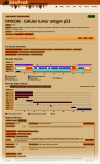DisProt 7.0: a major update of the database of disordered proteins
- PMID: 27899601
- PMCID: PMC5210544
- DOI: 10.1093/nar/gkw1056
DisProt 7.0: a major update of the database of disordered proteins
Erratum in
-
Corrigendum: DisProt 7.0: a major update of the database of disordered proteins.Nucleic Acids Res. 2017 Jan 4;45(D1):D1123-D1124. doi: 10.1093/nar/gkw1279. Epub 2016 Dec 13. Nucleic Acids Res. 2017. PMID: 27965415 Free PMC article. No abstract available.
Abstract
The Database of Protein Disorder (DisProt, URL: www.disprot.org) has been significantly updated and upgraded since its last major renewal in 2007. The current release holds information on more than 800 entries of IDPs/IDRs, i.e. intrinsically disordered proteins or regions that exist and function without a well-defined three-dimensional structure. We have re-curated previous entries to purge DisProt from conflicting cases, and also upgraded the functional classification scheme to reflect continuous advance in the field in the past 10 years or so. We define IDPs as proteins that are disordered along their entire sequence, i.e. entirely lack structural elements, and IDRs as regions that are at least five consecutive residues without well-defined structure. We base our assessment of disorder strictly on experimental evidence, such as X-ray crystallography and nuclear magnetic resonance (primary techniques) and a broad range of other experimental approaches (secondary techniques). Confident and ambiguous annotations are highlighted separately. DisProt 7.0 presents classified knowledge regarding the experimental characterization and functional annotations of IDPs/IDRs, and is intended to provide an invaluable resource for the research community for a better understanding structural disorder and for developing better computational tools for studying disordered proteins.
© The Author(s) 2016. Published by Oxford University Press on behalf of Nucleic Acids Research.
Figures


References
Publication types
MeSH terms
Substances
LinkOut - more resources
Full Text Sources
Other Literature Sources
Miscellaneous

